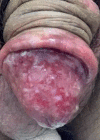Thalidomide in plasma cell balanitis refractory to conventional topical treatment
- PMID: 30484535
- PMCID: PMC6256201
- DOI: 10.1590/abd1806-4841.20187462
Thalidomide in plasma cell balanitis refractory to conventional topical treatment
Abstract
Zoon's plasma cell balanitis is a chronic genital inflammatory dermatosis that affects uncircumcised men, especially the elderly. It's characterized by painless erythematous plaques of orange hue, located on the glans penis and foreskin. Circumcision is the most effective treatment; however, it can be hard for patients to accept. As an alternative, topical calcineurin inhibitors are used, with good response. This article reports the case of a 32-year-old patient, HIV carrier, diagnosed with Zoon's plasma cell balanitis. Treatment with topical tacrolimus was administered, without improvement. A 6-week course of thalidomide resulted in complete remission of the lesions, without recurrence after eight months of follow-up.
Conflict of interest statement
Conflict of interest: None.
Figures




Similar articles
-
Zoon's plasma cell balanitis: a report of two cases treated with pimecrolimus.An Bras Dermatol. 2011 Jul-Aug;86(4 Suppl 1):S35-8. doi: 10.1590/s0365-05962011000700008. An Bras Dermatol. 2011. PMID: 22068766 English, Portuguese.
-
[Ulcerative Zoon's balanitis].Rev Med Liege. 2023 Jul;78(7-8):448-450. Rev Med Liege. 2023. PMID: 37560959 French.
-
Circumcision as treatment for Zoon's balanitis in an HIV-positive teenage patient.Int J STD AIDS. 2013 Oct;24(10):837-9. doi: 10.1177/0956462413486456. Epub 2013 Jul 15. Int J STD AIDS. 2013. PMID: 23970603
-
Zoon's balanitis successfully treated with photodynamic therapy: Case report and literature review.Photodiagnosis Photodyn Ther. 2016 Mar;13:347-349. doi: 10.1016/j.pdpdt.2015.08.010. Epub 2015 Aug 28. Photodiagnosis Photodyn Ther. 2016. PMID: 26321748 Review.
-
Successful Management of Zoon's Balanitis with Topical Mupirocin Ointment: A Case Report and Literature Review of Mupirocin-Responsive Balanitis Circumscripta Plasmacelluaris.Dermatol Ther (Heidelb). 2017 Jun;7(2):203-210. doi: 10.1007/s13555-017-0178-1. Epub 2017 Apr 5. Dermatol Ther (Heidelb). 2017. PMID: 28382428 Free PMC article. Review.
Cited by
-
Zoon's Balanitis - Update of Clinical Spectrum and Management.Indian J Dermatol. 2024 Jan-Feb;69(1):63-73. doi: 10.4103/ijd.ijd_834_22. Epub 2024 Feb 27. Indian J Dermatol. 2024. PMID: 38572053 Free PMC article. Review.
References
-
- Delgado L, Brandt HR, Ortolan DG, Patriota RC, Criado PR, Belda Junior W. Balanite plasmocitária de Zoon: relato de dois casos tratados com pimecrolimo. An Bras Dermatol. 2011;86:35–38. - PubMed
-
- Andrade SMF, Lorenski FR, Pinto DCS, Tebcherani A, Pontes MC. Laser fracionado de CO2 e ácido fusídico na balanite de Zoon: relato de caso. Surg Cosmet Dermatol. 2012;4:189–191.
-
- Kumar B, Narang T, Dass Radotra B, Gupta S. Plasma cell balanitis: clinicopathologic study of 112 cases and treatment modalities. J Cutan Med Surg. 2006;10:11–15. - PubMed
-
- Weyers W, Ende Y, Schalla W, Diaz-Cascajo C. Balanitis of Zoon: a clinicopathologic study of 45 cases. Am J Dermatopathol. 2002;24:459–467. - PubMed
Publication types
MeSH terms
Substances
LinkOut - more resources
Full Text Sources
Medical
Research Materials

